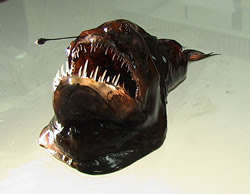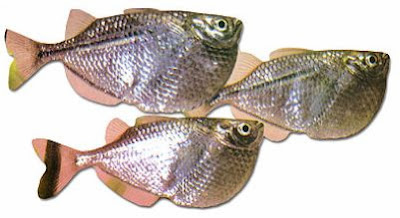Black-lip Rattail

These sorts of rattails feed in the muddy seafloor by gliding along head down and tail up, powered by gentle undulations of a long fin under the tail. The triangular head has sensory cells underneath that help detect animals buried in the mud or sand. The common name comes from the black edges around the mouth.
Humpback Anglerfish

This black seadevil, of the size of a tennis ball, is one of the weirdest fish in the world. Female humpback anglers have an enormous head dominated by a cavernous mouth full of long slender teeth that can fold backwards when prey is being swallowed.
Atlantic Wolffish

The Atlantic Wolffish is a large bottom-dwelling predatory marine fish. The species is widely distributed across the North Atlantic.
Axolotl

ou can learn more on this amphibian called axolotl on
http://www.axolotl.org/ . This one is in the same family than the tiger salamander. The only place on earth you can find those one are at Lake Xochimilco in Mexico.
Black Chimaera

Chimaeras are related to both sharks and rays. They are jawed fish with paired fins, paired nostrils, scales, two-chambered hearts, and skeletons made of cartilage rather than bone. Chimaeras grow up to two meters long, are found in the ocean floors and have a venomous spine which they use for defense purposes.
Black Swallower

The black swallower (Chiasmodon niger) is a deep sea fish that has the ability to extend its stomach 3 times its size so that it can swallow fish that are bigger than itself. It can be found in deep seas up to 1,500 meters or in hot tropical waters. It creates its own light because of the darkness found in some parts of the Pelagic zone. The black swallower can grow up to 25 centimeters.
Deep-sea glass squid

A martian? No, it’s the glass squid. This odd looking creature is located in the southern hemisphere and is the prey of many deep sea fish (ex: goblin sharks), whales and oceanic seabirds.
Deep-Sea Lizardfish

the Deep-Sea Lizardfish, is a member of the Synodontidae family, it is found throughout the world in tropical and subtropical seas at depths of between 600 and 3,500 m. It is considered as an ambush predator hunting in the abyssal seafloor and devouring prey with its razor sharp barbed teeth.
Dumbo Octopus

The deep-sea “Dumbo” octopus got its nickname from the ear-like fins protruding from the top of their “heads” (actually bodies), resembling the ears of Walt Disney ’s flying elephant . They are benthic creatures, living at extreme depths, and are some of the rarest of the Octopoda species.
Fangtooth Fish

Giant Hatchetfish

The giant hatchetfish is found in deep tropical and subtropical waters of all oceans, except the north Pacific. Its length is between 8 and 12 cm. The giant hatchetfish is a deep-bodied species with large eyes that are directed upwards, enabling prey to be silhouetted against the faint light coming from the surface, and a large mouth also directed upwards.
Lumpfish

The longest lumpfish so far recorded from the American coast measured 23 inches, and weighed 13¼ pounds; the heaviest weighed 20 pounds but measured only 21½ inches (both from Orient, N. Y.), and the proportion of weight to length varies similarly in smaller fish.
Mantis Shrimp

This highly intelligent hunter with claws can lash out at prey with the force of a gunshot. Larger varieties have been known to shatter glass or sever human fingers. Most are either “spearers” (with sharp, mantidlike claws) or “smashers” (with blunt, clublike claws for cracking hard-shelled prey). Rare among invertebrates are the monogamous mating habits that several species demonstrate. Mated pairs share a burrow, and the male hunts for both his mate and young.
Snaggletooth

Science experiment gone wrong? Sadly this is not the case. The Snaggletooth or Astronesthes slightly resembles the South American Payara without the charcoal finish and lack of scales. The Snaggletooth is a powerful predatory fish who resides in the deep waters between Australia and New Zealand.
Prehistoric Frilled Shark

Flaring the gills that give the species its name, a frilled shark swims at Japan's Awashima Marine Park on Sunday, January 21, 2007. Sightings of living frilled sharks are rare, because the fish generally remain thousands of feet beneath the water's surface. Spotted by a fisher on January 21, this 5.3-foot (160-centimeter) shark was transferred to the marine park, where it was placed in a seawater pool. "We think it may have come to the surface because it was sick, or else it was weakened because it was in shallow waters," a park official told the Reuters news service. But the truth may never be known, since the "living fossil" died hours after it was caught.
